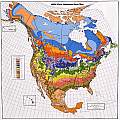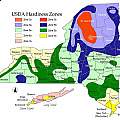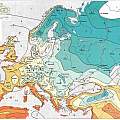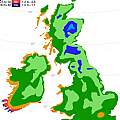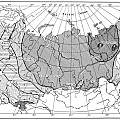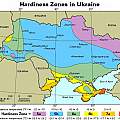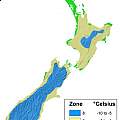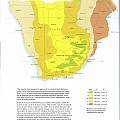Here are a number of Hardiness Zone Maps that all use the same USDA methodology and numbering system (for easy comparison among the regions). There are also a couple of Heat Zone Maps based on the American Horticultural Society methodology and numbering system, as well as some other explanations of plant hardiness in Europe and the former USSR regions.
Cold Hardiness Zone Maps
Note: the maps below are available for download but can be large so you may have a few minutes of waiting if you're not connected through highspeed.
North America (including Mexico and Canada). Download the map.
This is the original (actually the most recently updated (1990), second version of the original) hardiness zone map produced by the USDA (United States Department of Agriculture) that started it all. You can get a more detailed web version of specific (U.S. only) regions of this by going to http://www.usna.usda.gov/Hardzone/ushzmap.html. You can also get a more detailed look at the zone number key. I wish they would choose colors for the warmer zones (Zones 8 and above) that were more easily distinguishable from each other. (Most of the other maps listed here have done this.) This map also breaks each zone into an A sub-zone and a B sub-zone, where the A sub-zone is the cooler 5 degree part of the entire 10 degree (Fahrenheit) zone and the B sub-zone is the warmer 5-degree part of the zone. The A sub-zone is the paler colored one in each zone. Some people don't see a need for this subdivision, but I have found it useful and have found that it does distinguish which plants can be grown in an area, especially as you get closer to the zones where temperatures below freezing become important. Growing up in Austin, Texas (Zone 8B) I discovered that there were a lot of plants that don't survive well in Zone 8A that were listed as Zone 9 plants that do perfectly well in Zone 8B. This is probably also true at the Zone 9B/10A boundary. Zone 11 (and higher) areas are essentially frost-free all the time and have probably never measured a temperature below 0 degrees Celcius (freezing).
Canada Hardiness Zones
from Agriculture and Agri-Food Canada (sis.agr.gc.ca/cansis/nsdb/climate/hardiness/plant_poster.zip)
USA Hardiness Zones
from the Arbor Day Foundation, 2006 version (www.arborday.org/media/graphics/2006_zones.zip)
Alaska and Hawai`i
from the Arbor Day Foundation, 2006 version (www.arborday.org/media/graphics/2006_hi_ak.zip)
Europe hardiness map shown below
British Isles hardiness map shown below
Former USSR hardiness zone map and Mobotimages shown below
Ukraine hardiness zone map shown below
China
from (www.ars.usda.gov/SP2UserFiles/Place/36251200/Graphics/Climate_china.pdf)
Japan
by courtesy of Aboc-sha & Co., Ltd. (www.jelitto.com/english/japan.htm)
South America
(www.backyardgardener.com/zone/sazone.html)
Australia
from ©The Digger's Club 1998 (www.diggers.com.au/images/HCOLDZ01Large.jpg)
New Zealand
(www.liddlewonder.co.nz/zones.php)
Southern Africa hardiness zone map below scanned from The Ultimate Book of Trees & Shrubs for Southern African Gardeners, Southern Book Publishers (Pty) Ltd., 1996, ISBN 1 86812 677 3.
Heat Zone Maps
USA
(www.ahs.org/pdfs/05_heat_map.pdf)
Australia
from Diggers.com.au (www.diggers.com.au/images/HHEATZ01Large.jpg)
Other plant hardiness explanations
Comparison and Explanation of RHS (Royal Horticultural Society) and EGF (European Garden Flora)
(www.theseedsite.co.uk/hardiness.html)
Explanation of plant hardiness in the former USSR
(www.mobot.org/MOBOT/Research/russia/climatic.shtml)
